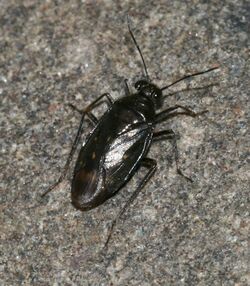Biology:Macrosaldula scotica
| Macrosaldula scotica | |
|---|---|

| |
| Scientific classification | |
| Domain: | Eukaryota |
| Kingdom: | Animalia |
| Phylum: | Arthropoda |
| Class: | Insecta |
| Order: | Hemiptera |
| Suborder: | Heteroptera |
| Family: | Saldidae |
| Genus: | Macrosaldula |
| Species: | M. scotica
|
| Binomial name | |
| Macrosaldula scotica (Curtis, 1835)
| |
| Synonyms[1][2] It is the type species of the genus Macrosaldula.[2] | |
| |
Macrosaldula scotica is a predatory species of true bug, from the family Saldidae in the order Hemiptera from the western Palearctic.[3]
Description
Macrosaldula scotica is notable large species of bug with an unusually lengthy second segment in the antennae, being at least 2.2 times the length of the first segment. The first segment in the antenna and the lower and middle part of the femora have longitudinal black and white stripes. The front pair of wings are largely dark with a few pale spots. There is a sparse covering of short hairs which is more obvious in the anterior part of the body.[4]
Distribution
The species is widespread in boreomontane Europe. It occurs in Northern Europe well north of the Arctic Circle and in the British Isles in the North. In the South, they are common especially in the Alps, the Apennines mountains, the Massif Central and the Pyrenees. It is found also in the Caucasus mountains and the Atlas mountains of Morocco. In Central Europe it is found in the central uplands and the Alps from 900 to 1800 meters above sea level.[5]
Habitat and biology
Macrosaldula scotica is usually recorded running over rocks and boulders along the margins of upland and mountain streams.[4] In Russia it can be found near low-lying rivers.[2]
Like other Saldidae Macrosaldula scotica is a very active predator of smaller insects and other arthropods, very agile on the ground and making jumping flights.[6]
The larvae of Macrosaldula scotica hatch out in June. The adults are active and readily take flight, although they will hide among pebbles on cloudy days. The adults are active from June to October. The adults and larvae can overwinter, it is thought that this species can also overwinter as eggs.[2]
References
- ↑ "Macrosaldula scotica". National Biodiversity Network. https://species.nbnatlas.org/species/NHMSYS0020309408#overview. Retrieved 9 March 2020.
- ↑ 2.0 2.1 2.2 2.3 N. N. Vinokurov (2014). "Review of the Genus Macrosaldula Southwood et Leston, 1959 (Heteroptera, Saldidae) of the Fauna of Russia and Adjacent Countries". Entomological Review 94 (7): 981-999.
- ↑ "Macrosaldula scotica (Curtis, 1835)". National Inventory of Natural Heritage. Muséum national d’Histoire naturelle. https://inpn.mnhn.fr/espece/cd_nom/237341/tab/taxo. Retrieved 9 March 2020.
- ↑ 4.0 4.1 "Macrosaldula scotica Family: Saldidae". British Bugs: An online identification guide to UK Hemiptera. Tristan Bantock & Joseph Botting. https://www.britishbugs.org.uk/heteroptera/Saldidae/Macrosaldula_scotica.html. Retrieved 9 March 2020.
- ↑ Ekkehard Wachmann; Albert Melber; Jürgen Deckert (2006). Wanzen. Band 1: Cimicomorpha: Dipsocoromorpha, Nepomorpha, Gerromorpha, Leptopodomorpha, Cimicomorpha (Teil 1). Die Tierwelt Deutschlands und der angrenzenden Meeresteile nach ihren Merkmalen und nach ihrer Lebensweise 77 Teil. Goecke & Evers, Keltern. ISBN 3-931374-49-1.
- ↑ Burrows M (2009). "Jumping strategies and performance in shore bugs (Hemiptera, Heteroptera, Saldidae)". Journal of Experimental Biology 212 (1): 106-15. doi:10.1242/jeb.024448.
Wikidata ☰ Q10574342 entry
 |

